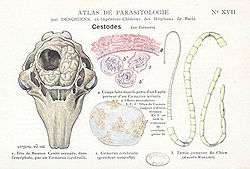Coenurosis
Coenurosis, also known as caenurosis, coenuriasis, gid or sturdy, is a parasitic infection that develops in the intermediate hosts of some tapeworm species (Taenia multiceps,[1] T. serialis,[2] T. brauni, or T. glomerata). It is caused by the coenurus, the larval stage of these tapeworms. The disease occurs mainly in sheep and other ungulates,[3] but occasionally can occur in humans by accidental ingestion of tapeworm eggs.

Adult worms of these species develop in the small intestine of the definitive hosts (dogs, foxes and other canids), causing a disease from the group of taeniasis.[4] Humans cannot be definitive hosts for these species of tapeworms.
In wild animals
Although coenurosis is more commonly associated with domestic animals, it has also been documented in wildlife, such as in mountain ungulates in the French Alps. It is believed that the ungulates are being contaminated by infected sheepdogs. Understanding how this disease is transmitted from sheepdogs to wild animals is important in managing the spread of this potentially dangerous zoonotic disease. A potential management strategy would be for farmers to properly dispose of carcasses that they find on their land. In wild gelada monkeys in Ethiopia, coenurosis was found to affect the fitness of these primates[5][6]. Mortality increased and fertility was inhibited. The disease has also been documented in wild sheep and other ruminants and rarely documented in rodents, horses and cats. Very few cases have been identified, but this could be the result of limited research on wild coenurosis. Animals infected with the disease tend to hide or take cover from predators and therefore may not be seen by humans.
See also
References
- University of Pennsylvania - Veterinary Medicine: Taenia multiceps Homepage Archived 2010-07-10 at the Wayback Machine
- University of Pennsylvania - Veterinary medicine: Taenia serialis Homepage Archived 2010-07-10 at the Wayback Machine
- Stanford University: Coenurosis - Hosts
- Stanford University: Taeniasis
- Schneider-Crease I, Griffin RH, Gomery MA, Bergman TJ, Beehner JC (2017). "High mortality associated with tapeworm parasitism in geladas (Theropithecus gelada) in the Simien Mountains National Park, Ethiopia". American Journal of Primatology. 79 (9): e22684. doi:10.1002/ajp.22684.
- Nguyen N, Fashing PJ, Boyd DA, Barry TS, Burke RJ, Goodale CB, Jones SC, Kerby JT, Kellogg BS, Lee LM, Miller CM, Nurmi NO, Ramsay MS, Reynolds JD, Stewart KM, Turner TJ, Venkataraman VV, Knauf Y, Roos C, Knauf S (2017). "Fitness impacts of tapeworm parasitism on wild gelada monkeys at Guassa, Ethiopia". American Journal of Primatology. 77 (5): 579–594.